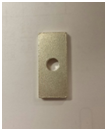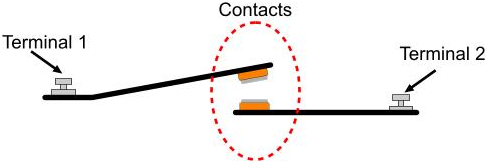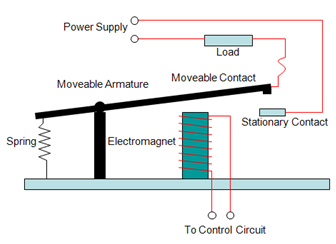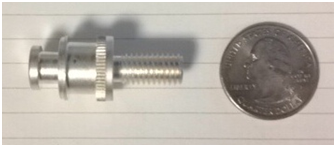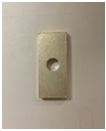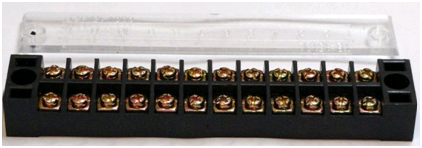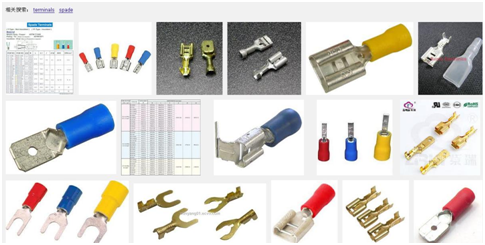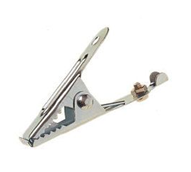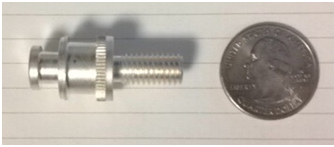作者:温朝柱
实际归类工作中经常会提出这样的疑问:品目85.36的“连接装置”有时候看起来也像“零件”的范围(比如接插件等),那么它与品目85.38的“连接装置”的专用零件到底有何区别?
笔者最近查到两个美国海关的ruling,即关于继电器的接触片和柱状触头的归类实例,希望各位读完本文之后能对类似商品的归类有所帮助。
商品一:继电器接触片
该制品是一个小的矩形金属片,中间钻一小孔,发票上描述为一个可动触点(moving contact)。其长约1英寸,用银电镀铜制成。如下图所示:
归类分析:
通常继电器由四部分组成:电磁铁、衔铁、弹簧和各种电气触头。
接触片具有平滑的表面,不像插头或插座那样的电气连接装置,也不像插入槽内的接线柱或线端条(The moving contact has flat, smooth surfaces and does not make an electrical connection like a plug or socket),所以该商品归入品目85.36不妥。 (a
plug may have one or more pins or side contacts which match corresponding holes or contacts in the socket), or terminal (metal
parts intended for the reception of conductors) or other connectors (small
metal parts designed to be fitted on the end of electrical wiring to facilitate electrical connection) described in the EN to heading 8536, HTSUS. In its imported condition,the moving contact is not fitted with means of electrical connection.
Therefore, the moving contact is not an apparatus of heading 8536
从商品的结构判断,它是专用于继电器的,如果不安装此商品,继电器将不能正常工作,所以它是继电器的“零件”。该商品也不属于84章、85章列名的商品,所以依据第十六类注释二(二)将此商品归入品目85.38项下。
商品二:继电器柱状触头
该制品是一个小圆筒状的金属触头,发票上描述为销状触头(pin contact)。其长大约2英寸,一端带有螺纹。用银电镀铜制成。如下图所示:
附件1:
HQ H225038
July 2, 2014
CATEGORY: Classification
TARIFF NO.: 8538.90.8040
RE: Application for Further Review of Protest No. 2720-12-100039; Tariff classification of a relay contact (“moving contact”)
FACTS:
The article is
a small rectangular piece of metal, which is
described on the invoice to the entry documents as a
moving contact. According to the bill of materials, the moving contact (part number 0-1618026-5)
measures
approximately 1 inch long. The
moving contact is made of copper with silver plating.
It is pictured below:
The moving contact is listed in the bill of materials as one of many components for relay assembly EV200 SPST-NO 12V (part number 2098190-1). The moving contact is not sold separately from the relay.
The merchandise was entered on one entry on September 19, 2010, and classified under subheading 8538.90.80, HTSUS, as “[p]arts suitable for use solely or principally with the apparatus of heading 8535, 8536 or 8537: [o]ther: [o]ther: [o]ther.” CBP liquated
the entry on August 5, 2011. Tyco filed its Protest and AFR on January 23, 2012, asserting that pursuant to NY N187857, dated November 2011, concerning the classification of pin contacts and matching sockets,
the moving contacts are classifiable under heading 8536, HTSUS, as “[e]lectrical apparatus for switching or protecting circuits, or for making connections to or in electrical circuits (for example, switches, relays, fuses, surge suppressors, plugs,
sockets, lamp-holders and other connectors, junction boxes), for a voltage not exceeding 1,000V; connectors for optical fibers, optical fiber bundles or cables.”
ISSUE:
Whether the moving contact is classified as an electrical apparatus for making connections to or in electrical circuits under heading 8536, HTSUS, or under heading 8538,
HTSUS, as a part suitable for use solely or principally with an apparatus of heading 8536.
LAW AND ANALYSIS:
Classification under the HTSUS is made in accordance with the General Rules of Interpretation (GRI). GRI 1 provides that the classification of goods shall be “determined according to the terms of the headings and any relative section or chapter notes.”
In the event that the goods cannot be classified solely on the basis of GRI 1 and if the headings and legal notes do not otherwise require, the remaining GRIs 2 through 6 may be applied in order.
The 2010 HTSUS headings under consideration in this case are as follows:
8536 Electrical apparatus for switching or protecting electrical circuits, or for making connections to or in electrical
circuits (for example, switches, relays, fuses, surge suppressors, plugs, sockets, lamp-holders and other connectors, junction boxes), for a voltage not exceeding 1,000 V; connectors for optical fibers, optical fiber bundles or cables.
8538 Parts suitable for use solely or principally with the apparatus of heading 8535, 8536 or 8537:
Legal Note 2 to Section XVI provides in relevant part the following:
2. Subject to note 1 to this section, note 1 to chapter 84 and to note 1 to chapter 85, parts of machines (not being parts of the articles of heading 8484, 8544, 8545, 8546 or 8547) are to be classified according to the following rules:
Parts which are goods included in any of the headings of chapter 84 or 85 (other than headings 8409, 8431, 8448, 8466, 8473, 8487, 8503, 8522, 8529, 8538 and 8548) are in all cases to be classified in their respective headings;
Other parts, if suitable for use solely or principally with a particular kind of machine, or with a number of machines of the same heading (including a machine of heading 8479 or 8543) are to be classified with the machines of that kind or in heading
8409, 8431, 8448, 8466, 8473, 8503, 8522, 8529, or 8538 as appropriate. However, parts which are equally suitable for use principally with the goods of headings 8517 and 8525 to 8528 are to be classified in heading 8517;
* * *
In understanding the language of the HTSUS, the Explanatory Notes (ENs) of the Harmonized Commodity Description and Coding System, which constitute the official interpretation of the Harmonized System at the international level, may be utilized. The ENs,
although not dispositive or legally binding, provide a commentary on the scope of each heading, and are generally indicative of the proper interpretation of the HTSUS. See T.D. 89-80, 54 Fed. Reg. 35127 (August 23, 1989).
The ENs to heading 8536, HTSUS, provide in pertinent part, as follows:
APPARATUS FOR MAKING CONNECTIONS TO OR IN ELECTRICAL CIRCUITS
This apparatus is used to connect together various parts of an electrical circuit. It includes:
(A) Plugs, sockets and other contacts for connecting movable lead or apparatus to an installation which is usually fixed. This category includes:
Plugs and sockets (including those for connecting two movable leads). A plug may have one or more pins or side contacts which match corresponding holes or contacts in the socket[.]
* * *
(B) Other connectors, terminals, terminal strips, etc. These include small squares of insulating material fitted with electrical connectors (dominoes), terminals which are metal parts intended for the reception of conductors, and small metal parts designed to be fitted on the end of electrical wiring to facilitate electrical connection (spade terminals, crocodile clips, etc.).
* * *
Dominoes
spade terminals(铲形线端)
crocodile_clip_mini鳄鱼夹
PARTS
Subject to the general provisions regarding the classification of parts (see the General Explanatory Note to Section XVI), parts of the apparatus of this heading are classified in heading 85.38.
* * *
The relevant ENs for heading 85.38, provide in pertinent part:
Subject to the general provisions regarding the classification of parts (see the General Explanatory Note to Section XVI), this heading covers parts of the goods of the three preceding headings.
There is no dispute that the relay assembly EV200 SPST-NO 12V (part number 2098190-1) is classified in heading 8536, HTSUS. Relays are a type of apparatus for switching electrical circuits. They are electrical devices by means of which the circuit is automatically controlled by a change in the same or another circuit. Relays
for a voltage not exceeding 1,000 volts are provided for in heading 8536, HTSUS. You argue that the moving contact is a part of the relay assembly that completes the electric connection.
As such, you argue that the moving contact is more akin to a terminal, in that it is a device that is attached to a conductor to facilitate a connection with another conductor. You conclude that the merchandise meets the terms of heading 8536, HTSUS,
as an electrical apparatus for making a connection to or in an electrical circuit. In support of your argument, you cite NY N187857, dated November 1, 2011, which classified crimp connector terminals, devices attached to the end of a conductor to facilitate a connection with another conductor, in heading 8536,
HTSUS.
According to our research at
www.howstuffworks.com, there are four parts in every relay:
an electromagnet; an armature that can be attracted by the electromagnet; a spring; and a set of electrical contacts. According
to our research at
www.pcbheaven.com, “How Relays Work”, the contact is a small piece of metal (see the illustration pictured below)
that is pulled by an electromagnet acting on a moving armature.
The moving armature operates the relay contacts. According
to
www.kgtechnologies.net/glossary-contact.php, “SPST-NO” relays are single pole single throw, meaning that they operate one circuit with Normally Open
contacts. The NO (Normal Open) contact is illustrated below. When the moving armature brings a contact “into contact”, current flows from terminal 1 to terminal 2. When the contact is still, no current flows through it (because it is an OPEN circuit).
See www.pcbheaven.com.
An article is to be classified according to its condition as imported. See XTC Products, Inc. v. United States, 771 F. Supp. 401, 405 (1991); see also United States v. Citroen, 223 U.S. 407 (1911). Protestant imports the moving contacts alone and unattached
to the armature and the spring.The moving contact has flat, smooth surfaces and does not make an electrical connection like a plug or socket (a plug may have one or more pins or side contacts which match corresponding holes or contacts in the socket), or terminal (metal parts intended for the reception of conductors) or other connectors (small metal parts designed to be fitted on the end of electrical wiring to facilitate electrical connection) described in the EN to heading 8536, HTSUS. In its imported condition,the moving contact is not fitted with means of electrical connection. Therefore, the moving contact is not an apparatus of heading 8536, HTSUS.
Subject to certain exceptions that are not relevant here, goods that are identifiable as parts of machines or apparatus of Chapter 84 or Chapter 85 are classifiable in accordance with Note 2 to Section XVI, HTSUS.
From the product specifications provided, it is evident that the moving contact is solely dedicated for use with the relay, and that the relay cannot function without the moving contact. Therefore,
the moving contact is considered a “part” of the relay.
Because the moving contacts are a part of a larger apparatus that is classifiable under Chapter 85, we apply Note 2 to Section XVI. The Court of International Trade has interpreted the application of this Note in the following manner:
Note 2(b) establishes that parts are to be classified with the goods with which they are principally used unless such parts have a particular or respective heading as specified by Note 2(a), except for the headings listed in the parentheses in Note 2(a)
which are themselves "parts" provisions. These "parts" headings are specifically excluded from the scope of Note 2(a) by the force of the "other than" provision in the parentheses, and thus these parts are not "to be classified in their respective
headings," but rather are to be classified, in accordance with 2(b), "with the machines of that kind or heading."
ENI Technology Inc. v. United States, 641 F. Supp. 2d 1337, 1350 (Ct. Int’l Tr. 2009).
The moving contact is not a good included in a heading of Chapters 84 or 85. Therefore, Note 2(a) to Section XVI does not apply. Note 2(b) to Section XVI in part provides that parts which do not meet the criteria of Note 2(a) are classified as parts, provided they are suitable for use solely or principally with a particular good. According to the schematics provided by the importer, the moving contacts are designed to be used specifically with relay assembly EV200
SPST-NO 12V (part number 2098190-1). They are made of copper with a precise plating of silver. They are engineered to precise dimensions, that is, to a specific length, width, and thickness, and with precise edge breaks. Therefore, the moving contacts are suitable for use solely or principally with the relay.
They are classified pursuant to Section XVI Note 2(b) in heading 8538, HTSUS, as parts suitable for use principally with the apparatus of Heading 8536.
HQ H225037
July 2, 2014
CLA-2 OT:RR:CTF:TCM H225037 RES
CATEGORY: Classification
TARIFF NO.: 8538.90.80
RE: Application for Further Review of Protest No. 2720-12-100037; Tariff classification of pin contacts.
FACTS:
The article is a
small cylindrical-like piece of metal, which
is described on the invoice to the entry documents as a pin contact. According to the bill of materials, the
pin contact (part number
3-1618025-7)
measures approximately 2 inches long and is threaded on one end. The pin contact is made of
copper with silver plating. It
is pictured below (the quarter is for scale):
The pin contact is listed in the bill of materials as one of many components for relay assembly EV200
SPST-NO 12V (part number 2098190-1). The pin contact is not sold separately from the relay.
The merchandise was entered on February 2, 2011, and classified under subheading 8538.90.80, HTSUS, as “[p]arts suitable for use solely or principally with the apparatus of heading 8535, 8536 or 8537: [o]ther: [o]ther: [o]ther.” CBP liquated the
entry on December 16, 2011. Tyco filed its Protest and AFR on January 23, 2012, asserting that the pursuant to NY N187857, dated November 1, 2011, concerning the classification of pin contacts and matching circuits, the pin contact is classifiable
under heading 8536, HTSUS, as “[e]lectrical apparatus for switching or protecting circuits, or for making connections to or in electrical circuits (for example, switches, relays, fuses, surge suppressors, plugs, sockets, lamp-holders and other connectors,
junction boxes), for a voltage not exceeding 1,000V; connectors for optical fibers, optical fiber bundles or cables.”
ISSUE:
Whether the pin contact is classified as an electrical apparatus for making connections to or in electrical circuits under heading 8536, HTSUS, or under heading 8538, HTSUS,
as a part suitable for use solely or principally with an apparatus of heading 8536.
LAW AND ANALYSIS:
Classification under the HTSUS is made in accordance with the General Rules of Interpretation (GRI). GRI 1 provides that the classification of goods shall be “determined according to the terms of the headings and any relative section or chapter
notes.” In the event that the goods cannot be classified solely on the basis of GRI 1 and if the headings and legal notes do not otherwise require, the remaining GRIs 2 through 6 may be applied in order.
The 2011 HTSUS headings under consideration in this case are as follows:
8536 Electrical apparatus for switching or protecting electrical circuits, or for making connections to or in electrical circuits (for example, switches, relays, fuses, surge suppressors, plugs, sockets, lamp-holders and other connectors,
junction boxes), for a voltage not exceeding 1,000 V; connectors for optical fibers, optical fiber bundles or cables.
8538 Parts suitable for use solely or principally with the apparatus of heading 8535, 8536 or 8537:
Legal Note 2 to Section XVI provides in relevant part the following:
2. Subject to note 1 to this section, note 1 to chapter 84 and to note 1 to chapter 85, parts of machines (not being parts of the articles of heading 8484, 8544, 8545, 8546 or 8547) are to be classified according to the following rules:
(a) Parts which are goods included in any of the headings of chapter 84 or 85 (other than headings 8409, 8431, 8448, 8466,
8473, 8487, 8503, 8522, 8529, 8538 and 8548) are in all cases to be classified in their respective headings;
(b) Other parts, if suitable for use solely or principally with a particular kind of machine, or with a number of machines
of the same heading (including a machine of heading 8479 or 8543) are to be classified with the machines of that kind or in heading 8409, 8431, 8448, 8466, 8473, 8503, 8522, 8529, or 8538 as appropriate. However, parts which are equally suitable
for use principally with the goods of headings 8517 and 8525 to 8528 are to be classified in heading 8517;
* * *
In understanding the language of the HTSUS, the Explanatory Notes (ENs) of the Harmonized Commodity Description and Coding System, which constitute the official interpretation of the Harmonized System at the international level, may be utilized.
The ENs, although not dispositive or legally binding, provide a commentary on the scope of each heading, and are generally indicative of the proper interpretation of the HTSUS. See T.D.
89-80, 54 Fed. Reg. 35127 (August 23, 1989).
The ENs to heading 8536, HTSUS, provide in pertinent part, as follows:
APPARATUS FOR MAKING CONNECTIONS TO OR IN
ELECTRICAL CIRCUITS
This apparatus is used to connect together various parts of an electrical circuit. It includes:
(A) Plugs, sockets and other contacts for connecting movable lead or apparatus to an installation which is usually fixed. This category includes:
(1) Plugs and sockets (including
those for connecting two movable leads). A plug may have one or more pins or side contacts which match corresponding holes or contacts in the socket[.]
* * *
(B) Other connectors, terminals, terminal strips, etc.These include small squares of insulating material fitted with electrical connectors (dominoes), terminals which are metal parts intended for the reception of conductors, and small metal parts designed to be fitted on the end of electrical wiring to facilitate electrical connection (spade terminals, crocodile clips, etc.).
* * *
PARTS
Subject to the general provisions regarding the classification of parts (see the General Explanatory Note to Section XVI), parts of the apparatus of this heading
are classified inheading 85.38.
* * *
The relevant ENs for heading 85.38, provide in pertinent part:
Subject to the general provisions regarding the classification of parts (see the General Explanatory Note to Section XVI), this heading covers parts of the goods of the three preceding headings.
There is no dispute that the relay assembly EV200 SPST-NO 12V (part number 2098190-1) is classified in heading 8536,
HTSUS. Relays are a type of apparatus for switching electrical circuits. They are electrical devices by means of which the circuit is automatically controlled by a change in the same or another circuit. Relays
for a voltage not exceeding 1,000 volts are provided for in heading 8536, HTSUS. You argue that the pin contact is a part of the relay assembly that completes the electric connection.
As such, you argue that the pin contact is more akin to a terminal, in that it is a device that is attached to a conductor to facilitate a connection with another conductor. You conclude that the merchandise meets the terms of heading 8536, HTSUS,
as an electrical apparatus for making a connection to or in an electrical circuit. In support of your argument, you cite NY N187857, dated November 1, 2011, which classified crimp connector terminals, devices attached to the end of a conductor
to facilitate a connection with another conductor, in heading 8536, HTSUS.
An article is to be classified according to its condition as imported. See XTC Products, Inc. v. United States, 771 F. Supp. 401, 405 (1991);
see also United States v. Citroen,
223 U.S. 407 (1911). Protestant imports the pin contacts alone. The pin contact has a cylindrical shape with screw threads on one end. The pin contacts are screwed into the relay and connect the relay to wires of an electrical circuit. In its imported condition, the pin contact is not fitted with means of electrical connection.
Therefore, the moving contact is not an apparatus of heading 8536, HTSUS.
Subject to certain exceptions that are not relevant here, goods that are identifiable as parts of machines or apparatus of Chapter 84 or Chapter 85 are classifiable in accordance with Note 2 to Section XVI, HTSUS.
The courts have considered the nature of “parts” under the HTSUS and two distinct though not inconsistent tests have resulted. See Bauerhin Techs. Ltd. P’ship. v. United States (
Bauerhin), 110 F. 3d 774 (Fed. Cir. 1997). The first, articulated in United States v. Willoughby Camera Stores, Inc. (Willoughby)
, 21 C.C.P.A. 322, 324 (1933), requires a determination of whether the imported item is an “integral, constituent, or component part,
without which the article to which it is to be joined, could not function as such article.” Bauerhin, 110 F.3d at 778 (quoting Willoughby,
21 C.C.P.A. 322 at 324). The second, set forth inUnited States v. Pompeo ( Pompeo),
43 C.C.P.A. 9, 14 (1955), states that an “imported item dedicated solely for use with another article is a ‘part’ of that article within the meaning of the HTSUS.” Id. at
779 (citing Pompeo, 43 C.C.P.A. 9 at 13). Under either line of cases, an imported item is not a part if it is “a separate and distinct commercial entity.”
Bauherin, 110 F. 3d at 779.
More recently, the Court of International Trade applied the Willoughbyand Pompeo tests
when it addressed the issue of whether two vase-shaped glass structures were classifiable as glassware in heading 7013, HTSUS, or as parts of lamps in heading 9405, HTSUS. Pomeroy Collection, Ltd., v. United States,
783 F. Supp. 2d 1257, No. 11-78 (Ct. Int’l Trade 2011). In applying Willoughby to the first article, the court ruled that “[w]hen imported, the claimed
article is dedicated solely for use in such article, and, when applied to that use, the claimed part meets theWilloughby test.” Ibid
, at 1261-1262. In Pomeroy, the court found that first
article satisfied the Willoughby test because the hurricane lamp “clearly could not function without the first article in question” since the lamp relied
upon the glass structure to hang upon. Id. at 1262. The
court found that the second glass structure satisfied Pompeo because the evidence showed that the glass structure contained the flame and enabled the candles
to remain lit and to prevent open flames. Thus, the court also found that the second article at issue also satisfied theWilloughby precedent because “when applied
to that use” the lamp could not function without the glass structures. Id.
In other words, to satisfy the Pompeo test, two prongs must be
satisfied: (1) the article must be solely dedicated for use with the product it claimed to be a part of and, (2) when applied to that use, the article cannot function without the article at issue.
From the product specifications provided, it is evident that the pin contact is solely dedicated for use with the relay, and that the relay cannot function without the pin contact. If the pin contact were to fail, the relay would cease to function.
Therefore, the pin contact is considered a “part” of the relay.
Because the pin contacts are a part of a larger apparatus that is classifiable under Chapter 85, we apply Note 2 to Section XVI. The Court of International Trade has interpreted the application of this Note in the following manner:
Note 2(b) establishes that parts are to be classified with the goods with which they are principally used unless such parts have a particular or respective heading
as specified by Note 2(a), except for the headings listed in the parentheses inNote 2(a) which are themselves "parts" provisions. These "parts" headings are specifically excluded from the scope of Note 2(a) by the force of the "other than" provision in the parentheses, and thus these parts are not "to be classified in their respective headings," but rather are to be classified, in accordance with 2(b), "with the machines of that kind or heading."
The pin contact is not a good included in a heading of Chapters 84 or 85. Therefore, Note 2(a) to Section XVI does not apply. Note 2(b) to
Section XVI in part provides that parts which do not meet the criteria of Note 2(a) are classified as parts, provided they are suitable for use solely or principally with a particular good. According to the schematics provided by the importer,
the pin contacts are designed to be used specifically with relay assembly EV200 SPST-NO 12V (part number 2098190-1). It is made of copper with a precise plating of silver. It is engineered to precise dimensions. Therefore, the pin contacts
are suitable for use solely or principally with the relay. It is classified pursuant to Section XVI Note 2(b) in heading 8538, HTSUS, as parts suitable for use principally with the apparatus of Heading 8536.
The importer claims that the classification of the pin contacts under heading 8538, HTSUS, is inconsistent with CBP ruling NY N187857. The function and use of the articles in NY NY187857 was described, in relevant part, as follows:
The merchandise under consideration was identified as contact pins, . . .and matching sockets. . .Both the pins and sockets are designed to be crimped onto the end of a conductor, and are used in various connector applications such as ground support devices,
computer peripheral equipment, modems and industrial instrumentation. From the samples and information that you have provided, the contact pins and matching sockets are pin and receptacle crimp connectors. . .
As described above, the articles in NY N187857 are not the same as the pin contacts at issue here. The articles in NY N187857 were called “contact pins and matching sockets”, they were more akin to crimp connector terminals, and were not components
or parts of a larger article, e.g., they were not parts of a relay. From the description in NY N187857, the crimp connector terminals appear to be sold individually to end consumers who would then use the pins and sockets in a variety of different
articles to connect such articles to copper wires. As such, NY N187857 does not determine the classification of the pin contacts at issue in this AFR.
Therefore, pursuant to Note 2(b) to Section XVI, the pin contacts are classified under heading 8538, HTSUS, as “[p]arts suitable for use solely or principally with the apparatus of heading 8535, 8536 or 8537.”
HOLDING:
Pursuant to GRIs 1 and 6, the pin contact is classified under heading 8538, HTSUS, and specifically under subheading 8538.90.8040, HTSUSA, which provides for “[p]arts suitable for use solely or principally with the apparatus of headings 8535, 8536 or 8537: [o]ther: [o]ther: [o]ther: [o]ther.” The column one, rate of duty, is 3.7 percent ad valorem.



